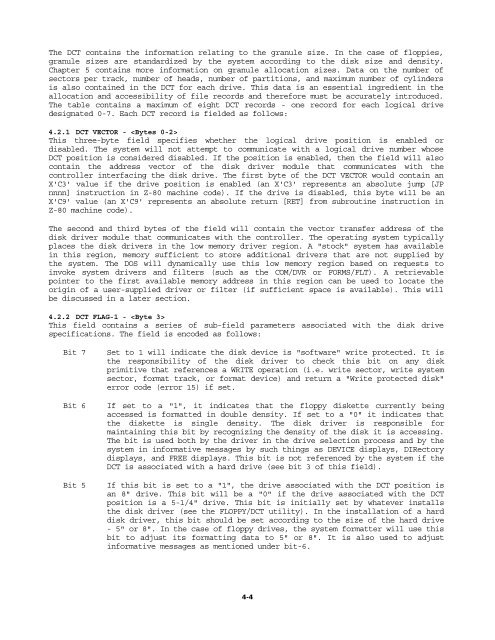The Programmer's Guide to TRSDOS Version 6 - Tim Mann's Home ...
The Programmer's Guide to TRSDOS Version 6 - Tim Mann's Home ...
The Programmer's Guide to TRSDOS Version 6 - Tim Mann's Home ...
You also want an ePaper? Increase the reach of your titles
YUMPU automatically turns print PDFs into web optimized ePapers that Google loves.
<strong>The</strong> DCT contains the information relating <strong>to</strong> the granule size. In the case of floppies,<br />
granule sizes are standardized by the system according <strong>to</strong> the disk size and density.<br />
Chapter 5 contains more information on granule allocation sizes. Data on the number of<br />
sec<strong>to</strong>rs per track, number of heads, number of partitions, and maximum number of cylinders<br />
is also contained in the DCT for each drive. This data is an essential ingredient in the<br />
allocation and accessibility of file records and therefore must be accurately introduced.<br />
<strong>The</strong> table contains a maximum of eight DCT records - one record for each logical drive<br />
designated 0-7. Each DCT record is fielded as follows:<br />
4.2.1 DCT VECTOR - <br />
This three-byte field specifies whether the logical drive position is enabled or<br />
disabled. <strong>The</strong> system will not attempt <strong>to</strong> communicate with a logical drive number whose<br />
DCT position is considered disabled. If the position is enabled, then the field will also<br />
contain the address vec<strong>to</strong>r of the disk driver module that communicates with the<br />
controller interfacing the disk drive. <strong>The</strong> first byte of the DCT VECTOR would contain an<br />
X'C3' value if the drive position is enabled (an X'C3' represents an absolute jump [JP<br />
nnnn] instruction in Z-80 machine code). If the drive is disabled, this byte will be an<br />
X'C9' value (an X'C9' represents an absolute return [RET] from subroutine instruction in<br />
Z-80 machine code).<br />
<strong>The</strong> second and third bytes of the field will contain the vec<strong>to</strong>r transfer address of the<br />
disk driver module that communicates with the controller. <strong>The</strong> operating system typically<br />
places the disk drivers in the low memory driver region. A "s<strong>to</strong>ck" system has available<br />
in this region, memory sufficient <strong>to</strong> s<strong>to</strong>re additional drivers that are not supplied by<br />
the system. <strong>The</strong> DOS will dynamically use this low memory region based on requests <strong>to</strong><br />
invoke system drivers and filters (such as the COM/DVR or FORMS/FLT). A retrievable<br />
pointer <strong>to</strong> the first available memory address in this region can be used <strong>to</strong> locate the<br />
origin of a user-supplied driver or filter (if sufficient space is available). This will<br />
be discussed in a later section.<br />
4.2.2 DCT FLAG-1 - <br />
This field contains a series of sub-field parameters associated with the disk drive<br />
specifications. <strong>The</strong> field is encoded as follows:<br />
Bit 7 Set <strong>to</strong> 1 will indicate the disk device is "software" write protected. It is<br />
the responsibility of the disk driver <strong>to</strong> check this bit on any disk<br />
primitive that references a WRITE operation (i.e. write sec<strong>to</strong>r, write system<br />
sec<strong>to</strong>r, format track, or format device) and return a "Write protected disk"<br />
error code (error 15) if set.<br />
Bit 6 If set <strong>to</strong> a "1", it indicates that the floppy diskette currently being<br />
accessed is formatted in double density. If set <strong>to</strong> a "0" it indicates that<br />
the diskette is single density. <strong>The</strong> disk driver is responsible for<br />
maintaining this bit by recognizing the density of the disk it is accessing.<br />
<strong>The</strong> bit is used both by the driver in the drive selection process and by the<br />
system in informative messages by such things as DEVICE displays, DIRec<strong>to</strong>ry<br />
displays, and FREE displays. This bit is not referenced by the system if the<br />
DCT is associated with a hard drive (see bit 3 of this field).<br />
Bit 5 If this bit is set <strong>to</strong> a "1", the drive associated with the DCT position is<br />
an 8" drive. This bit will be a "0" if the drive associated with the DCT<br />
position is a 5-1/4" drive. This bit is initially set by whatever installs<br />
the disk driver (see the FLOPPY/DCT utility). In the installation of a hard<br />
disk driver, this bit should be set according <strong>to</strong> the size of the hard drive<br />
- 5" or 8". In the case of floppy drives, the system formatter will use this<br />
bit <strong>to</strong> adjust its formatting data <strong>to</strong> 5" or 8". It is also used <strong>to</strong> adjust<br />
informative messages as mentioned under bit-6.<br />
4-4















